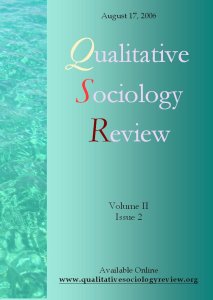The 35mm Solution: Photography, Scientists, and Whales
DOI:
https://doi.org/10.18778/1733-8077.2.2.09Keywords:
Animal studies, anthropomorphism, fieldwork, naming, photographic identification of cetacean, reliability and validity, sociology of science and scientific knowledgeAbstract
The field technique of photographic identification enabled scientists to individually identify and follow cetacea (whales, dolphins, and porpoises) through their life-cycle. Photographic identification relies on portable, highquality photographic equipment and the naturally occurring markings of individual whales. Being able to identify cetacea individually has enabled scientists to engage in long-term field studies comparable to field studies of land mammals. Further, carrying out long-term field studies has contributed to an exponential growth of scientific knowledge of cetacea and has significantly altered the public’s connection(s) to scientists and cetacea.
This article is based on interviews, published material, and observations made by the author at different research settings. It describes how photography and the use of naturally occurring markings of individual cetacea combined to produce photographic identification as a research technique.
As a study within the sociology of science and scientific knowledge, this article highlights the emergent character of scientific research; that is, the emergent confluence of cumulative knowledge, theory, method, and empirical observation.
Downloads
References
Alia, Valerie (1994) Names, Numbers, and Northern Policy. Halifax: Fernwood Publishing.
Google Scholar
Baker, C. Scott, Anjanette Perry and Gary Vequist (1988) “Humpback Whales of Glacier Bay, Alaska.” Whalewatcher 22(3):13-17.
Google Scholar
Becker, Howard (1982) Art Worlds. Berkeley: University of California Press.
Google Scholar
Bigg, Michael A, Graeme M. Ellis and Kenneth C. Balcomb (1986) “The Photographic Identification of Individual Cetaceans.” Whalewatcher 20(2): 10-12.
Google Scholar
Bigg, Michael, Ian MacAskie and Graeme Ellis (1983) “Photo-Identification of Individual Killer Whales.” Whalewatcher 17(3): 3-5.
Google Scholar
Childerhouse, John, and S.M. Dawson (1996) “Stability of Fluke Marks used in Individual Photo Identification of Male Sperm Whales at Kaikoura, New Zealand.” Marine Mammal Science 12(3): 447-451.
Google Scholar
DOI: https://doi.org/10.1111/j.1748-7692.1996.tb00597.x
Clapham, Phil (1994) “What’s in a Name?” Coastwatch 3(May/June): 4.
Google Scholar
Clarke, Adele E. and Joan H. Fujimura, editors (1992) The Right Tools for the Job: At work in Twentieth-Century Life Sciences. Princeton: Princeton University Press.
Google Scholar
DOI: https://doi.org/10.1515/9781400863136
Collins, H.M. (1983) “The Sociology of Scientific Knowledge: Studies of Contemporary Science.” Annual Review of Sociology 9:265-285.
Google Scholar
DOI: https://doi.org/10.1146/annurev.so.09.080183.001405
Collins, H.M. and Robert Evans (2002) “The Third Wave of Science Studies: Studies of Expertise and Experience.” Social Studies of Science 32(2): 235-296.
Google Scholar
DOI: https://doi.org/10.1177/0306312702032002003
Daston, Lorraine and Peter Galison (1992) “The Image of Objectivity.” Representations 40 (Autumn): 81-128.
Google Scholar
DOI: https://doi.org/10.2307/2928741
Davis, Susan G. (1997) Spectacular Nature: Corporate Culture and the Sea World Experience. Berkeley: University of California Press.
Google Scholar
DOI: https://doi.org/10.1525/9780520919532
Dewey, John and Arthur F. Bentley (1960) Knowing and the Known. Boston: Beacon Press.
Google Scholar
Flukeprints (1995) April – March. Gloucester, Massachusetts.
Google Scholar
Flukeprints (1994) April - March. Gloucester, Massachusetts.
Google Scholar
Ford, John K. (1985) “Acoustic traditions of killer whales.” Whalewatcher 19(3): 3-6.
Google Scholar
Ford, John K.B., Graeme M. Ellis and Kenneth C. Balcomb (1997) Killer Whales. Vancouver: University of British Columbia Press.
Google Scholar
Fujimura, Joan (1987) “Constructing ‘Do-able’ Problems in Cancer Research: Articulating alignment.” Social Studies of Science 17:257-293.
Google Scholar
DOI: https://doi.org/10.1177/030631287017002003
Goffman, Erving (1959) The Presentation of Self in Everyday Life. Garden City, NY: Anchor Books.
Google Scholar
Katona, Steven and Scott Kraus (1979) “Photographic Identification of Individual Humpback Whales (Megaptera novaeangliae): Evaluation and Analysis of the Technique.” Report No.MMC-77/17, Marine Mammal Commission, Washington, D.C.
Google Scholar
Kennedy, John S. (1992) The New Anthropomorphism. Cambridge: Cambridge University Press.
Google Scholar
DOI: https://doi.org/10.1017/CBO9780511623455
Knorr-Cetina, Karin D. (1983) “New developments in science studies: The ethnographic challenge.” Canadian Journal of Sociology 8: 153-177.
Google Scholar
DOI: https://doi.org/10.2307/3340124
Latour, Bruno and Steven Woolgar (1986) Laboratory life: The construction of scientific facts. Princeton, NJ: Princeton University Press.
Google Scholar
DOI: https://doi.org/10.1515/9781400820412
Lynch, Michael (1997) Scientific practice and ordinary action: Ethnomethodology and social studies of science. Cambridge: Cambridge University Press.
Google Scholar
Lynch, Michael (1985) Art and Artifact in Laboratory Science: A study of shop talk and shop talk in a Research Laboratory. London: Routledge and Kegan Paul.
Google Scholar
Maynard, Douglas W. and Nora Cate Schaeffer (2000) “Toward a Sociology of Social Scientific Knowledge.” Social Studies of Science 30 (3): 323-370.
Google Scholar
DOI: https://doi.org/10.1177/030631200030003001
Mulkay, Michael (1983) Science and the Sociology of Knowledge. London: George Allen and Unwin.
Google Scholar
Mulkay, Michael (1978) “Consensus in Science.” Social Science Information 17(1):107-122.
Google Scholar
DOI: https://doi.org/10.1177/053901847801700106
Nutch, Frank (1996) “Gadgets, Gizmos, and Instruments: Science for the Tinkering.” Science, Technology, and Human Values 2 (Spring): 214-228.
Google Scholar
DOI: https://doi.org/10.1177/016224399602100205
Obee, Bruce (1996) “Mysterious Orcas.” Beautiful British Columbia 38 (3): 14-21.
Google Scholar
Obee, Bruce (1992) “The Great Killer Whale Debate: Should Captive Orcas Be Set Free” Canadian Geographic 112 (1): 20-31.
Google Scholar
Phillips, Mary T. (1994) “Proper Names and the Social Construction of Biography: The Negative Case of Laboratory Animals.” Qualitative Sociology 17 (2):119-142.
Google Scholar
DOI: https://doi.org/10.1007/BF02393497
Roth, Wolff-Michael and G. Michael Bowen (2001) “Creative Solution and Fibbing Results: Enculturation in Field Ecology.” Social Studies of Science 31 (4): 533-
Google Scholar
DOI: https://doi.org/10.1177/030631201031004003
Roth, Wolff-Michael and G. Michael Bowen (1999) “Digitizing Lizards: The Topology of ‘Vision’ in Ecological Fieldwork.” Social Studies of Science 29 (5): 719-764.
Google Scholar
DOI: https://doi.org/10.1177/030631299029005003
Scarce, Rik (2000) Fishy Business: Salmon, biology, and the social construction of nature. Philadelphia: Temple University Press.
Google Scholar
Strauss, Anselm L. (1969) Mirrors and Masks. The Sociology Press.
Google Scholar
Wajcman, Judy (2002) “Addressing Technological Change: The Challenge to Social Theory.” Current Sociology 50 (3): 347-363.
Google Scholar
DOI: https://doi.org/10.1177/0011392102050003004
Zenzen, Michael and Sal Restivo (1982) “The mysterious morphology of immiscible liquids: A study of scientific practice.” Social Science Information 21: 447-473.
Google Scholar
DOI: https://doi.org/10.1177/053901882021003004
Downloads
Published
How to Cite
Issue
Section
License

This work is licensed under a Creative Commons Attribution-NonCommercial-NoDerivatives 4.0 International License.











